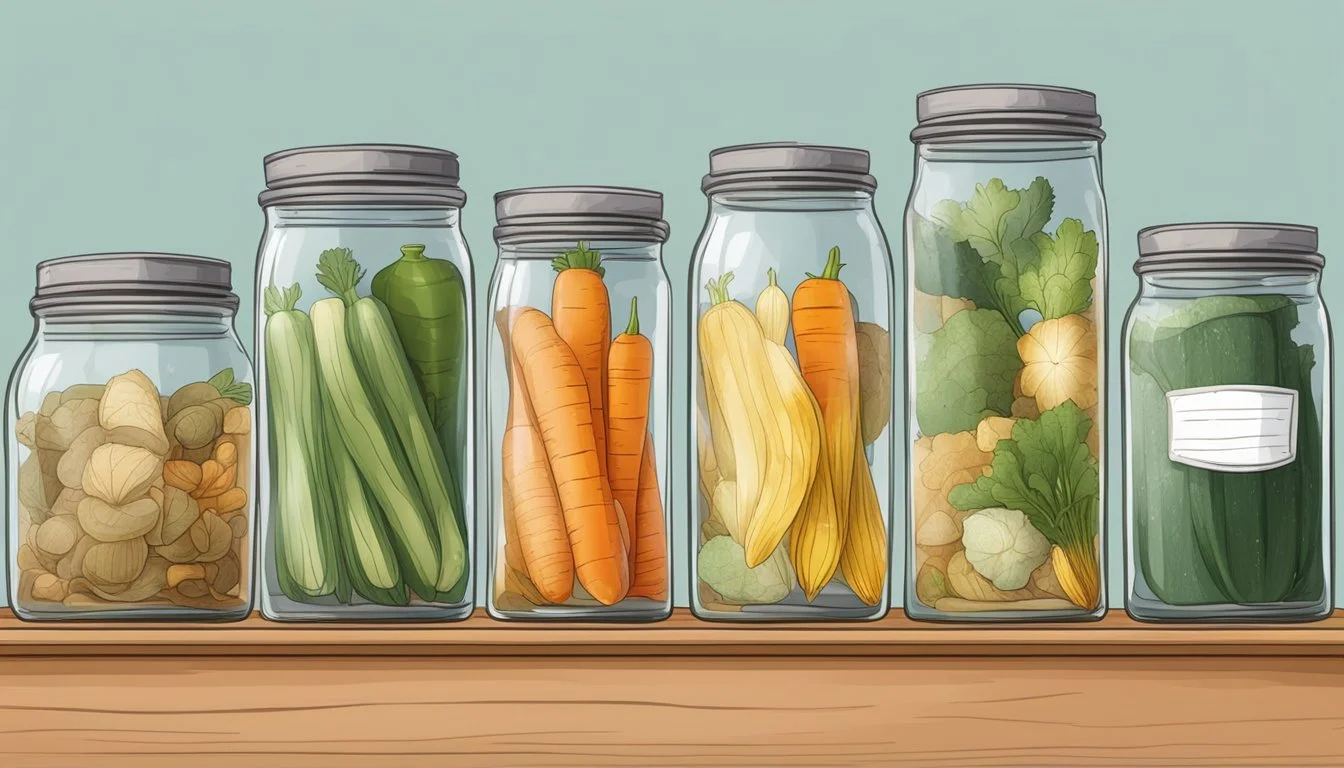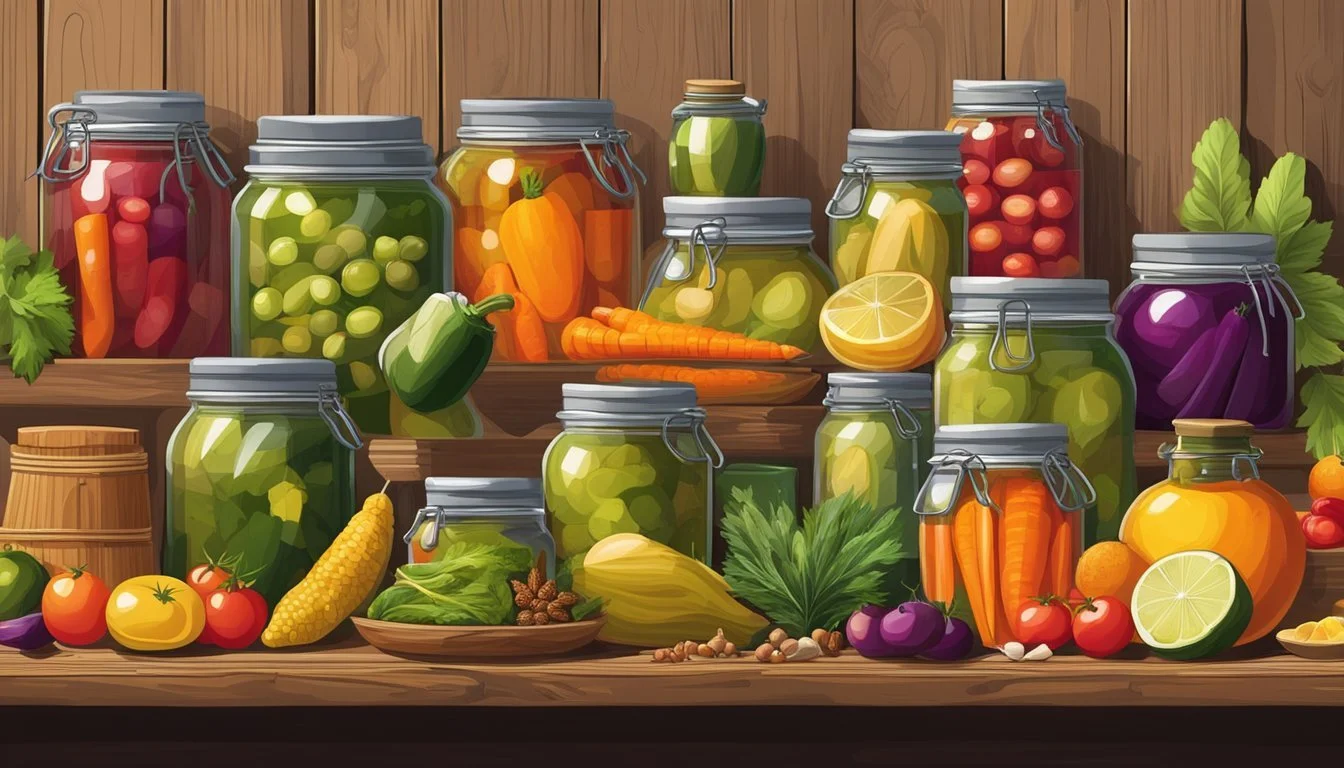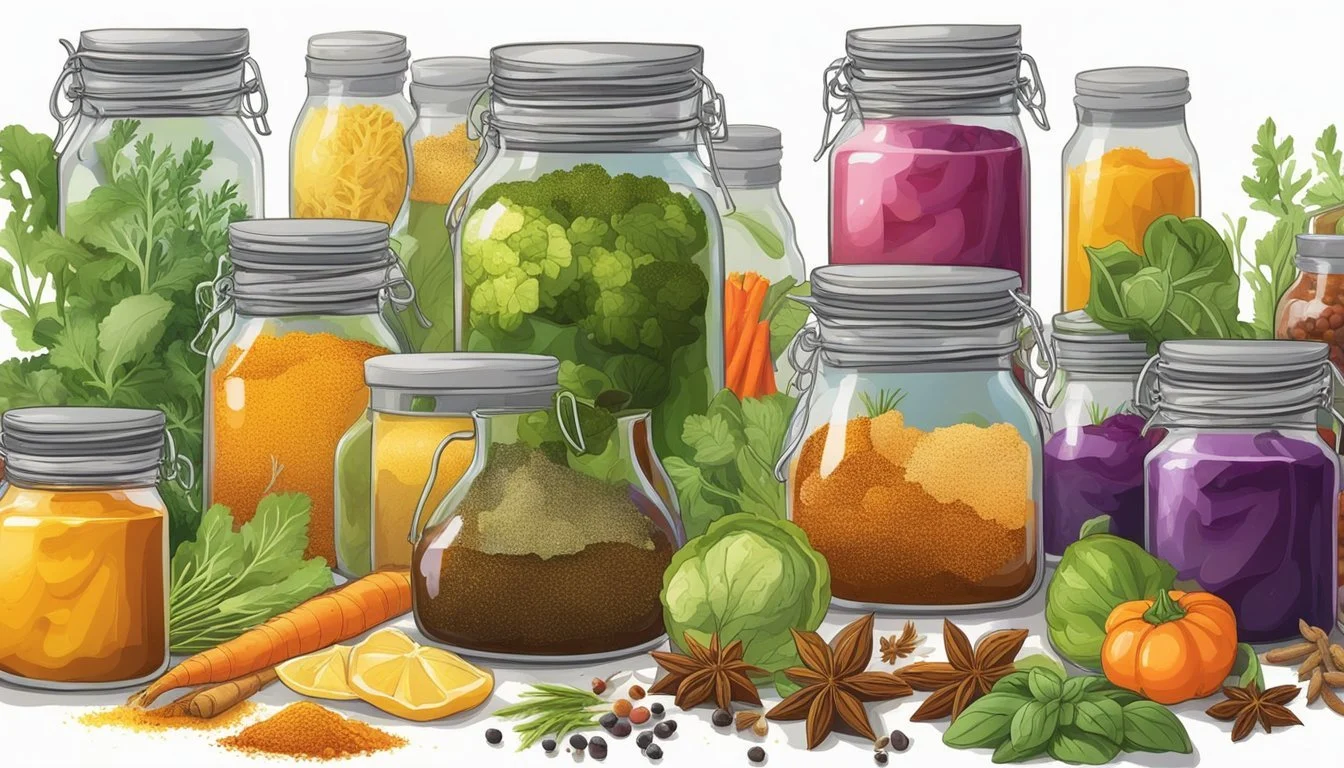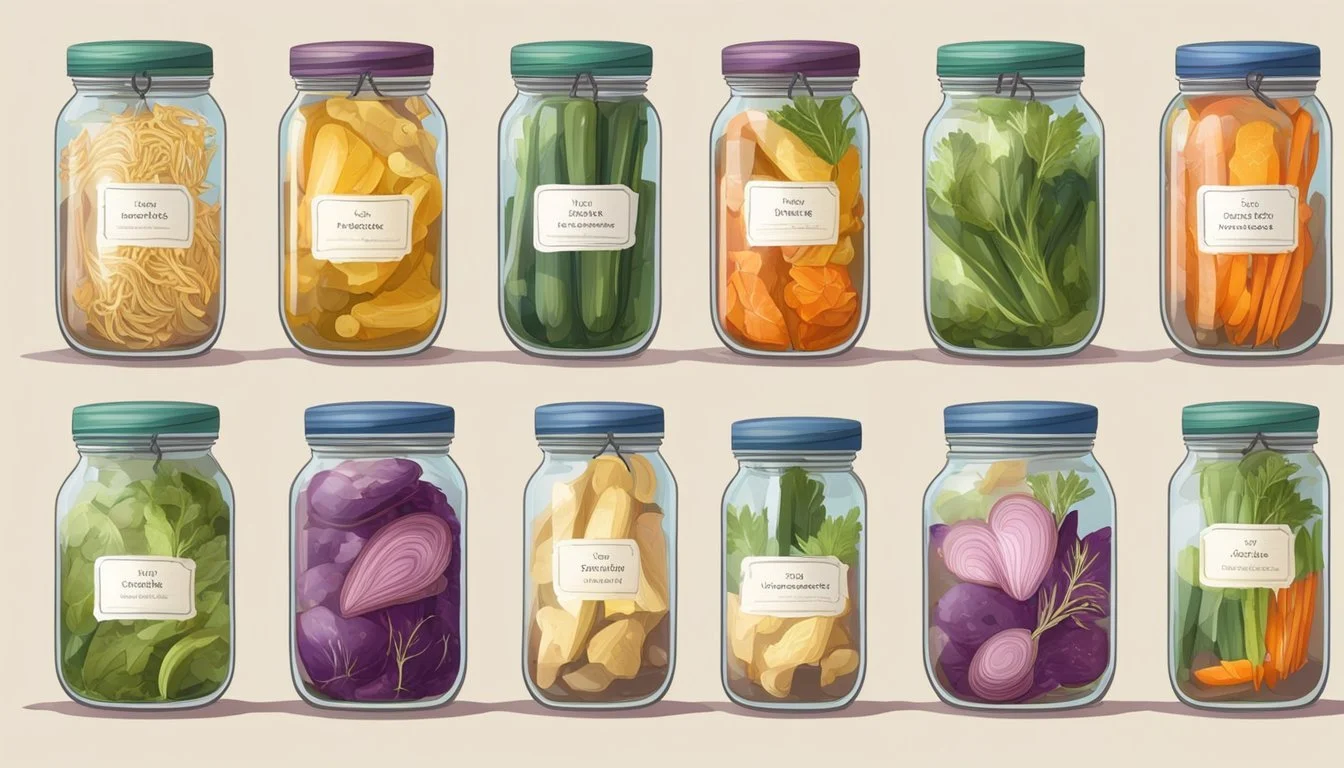The Art of Pickling
Master Techniques to Preserve Vegetable Scraps for Sustainability and Flavor
The practice of pickling vegetables is an age-old method that serves the dual purpose of preserving food and reducing waste. It is a technique that transforms leftover vegetable scraps, that might otherwise be discarded, into deliciously tangy, crisp preserved foods. Through a process of fermentation or immersion in an acidic solution, pickling extends the life of ingredients like carrot peelings, cauliflower stems, and radish tops, allowing these underutilized food parts to be savored well beyond their typical shelf life.
At its core, pickling is a simple chemical reaction where an acidic brine, typically made with water, vinegar, salt, and sugar, inhibits the growth of spoilage-causing microorganisms. Vegetables are submerged in this brine, sometimes with additional seasonings such as dill, mustard seeds, or garlic to enhance flavor. This transformative process not just preserves the vegetables but also imparts a unique taste and texture that has become a staple in culinary traditions around the world.
In the context of modern sustainability efforts, pickling stands out as an effective method to combat food wastage. By reclaiming vegetable scraps and converting them into pickled delicacies, households and chefs alike contribute to a decrease in the amount of organic matter that ends up in landfills. This act of preservation is not only practical but also a creative culinary adventure, giving way to a myriad of flavors and possibilities hidden in the remnants of everyday vegetable use.
Basics of Pickling
Pickling is the process of preserving foods in an acidic medium, such as vinegar, or through fermentation, which produces lactic acid. Proper acidity levels and methods are critical to the safety and flavor of pickled products.
Understanding Acidity and pH
Pickling requires a careful balance of acidity, which is necessary for both taste and food safety. The pH scale, ranging from 0 to 14, measures the acidity or alkalinity of a solution. Food-grade vinegar, typically with a 5% acidity level, is a key ingredient in maintaining the necessary pH for safe pickling, generally below 4.6. This level of acidity inhibits the growth of harmful bacteria, such as Clostridium botulinum, thus preserving the food.
Exploring Different Pickling Methods
There are two primary pickling methods: vinegar pickling and fermentation.
Vinegar Pickling: Combines vinegar, water, and salt—and often sugar—to create a brine. Vegetables submerged in this brine are typically processed in jars and can be either heat-sealed or refrigerated.
Ingredient Purpose Vinegar Preserves and flavors Water Dilutes acidity Salt Flavor and crispness Sugar (Optional) Balances sourness
Fermentation: Relies on saltwater brine where natural bacteria ferment the sugars in the food, creating lactic acid. This method often takes longer and requires careful monitoring to ensure a safe environment for good bacteria to thrive.
Safety Measures and Best Practices
Safety is paramount in pickling. It is crucial to use food-grade containers and utensils to prevent contamination. All ingredients must be fresh and free from spoilage, and containers should be sterilized before use.
Best Practices:
Only use approved recipes that follow safe food preservation guidelines.
Employ clean techniques, including thoroughly washing all food and utensils.
Ensure jars and seals are free from chips or cracks for proper sealing.
Monitor the seals and storage conditions to ensure the longevity and safety of pickled products.
By considering the acidity levels, employing proper pickling methods, and following safety best practices, one can ensure the successful preservation of food through pickling.
Ingredients and Equipment
To successfully pickle vegetables, one needs the proper ingredients and equipment. This ensures the preservation process is effective, flavors are enhanced, and the pickled vegetables (What wine goes well with pickled vegetables?) are safe for consumption.
Selecting the Right Vegetables
For pickling, one should choose fresh vegetables that are free from blemishes and signs of mold. Popular vegetables include cucumbers, carrots, cauliflower, green beans, and peppers. Cabbage is often used for fermentation, as seen in foods like sauerkraut and kimchi.
Choosing Spices and Herbs
The flavor of the pickled vegetables is greatly influenced by the spices and herbs used. Common spices include mustard seeds, peppercorns, and cloves, while herbs such as dill, rosemary, and coriander add a fresh note. For a unique twist, one might use cinnamon, ginger, or turmeric. When adding herbs and spices to the jar, they should be clean and free from moisture to prevent spoilage.
Essential Pickling Equipment
The equipment needed for pickling includes:
Jars: Glass canning jars with tight-sealing lids are preferred to ensure an airtight environment and prevent contamination.
Non-reactive saucepan: Ideally made of stainless steel for preparing the pickling brine.
Canning tongs: To safely handle the hot jars during the boiling water process.
Funnel: Helps in pouring the brine into jars without spillage.
Lid lifter: Useful for removing lids from boiling water if pre-sterilizing.
The process involves creating a pickling brine, typically a mixture of water, vinegar such as apple cider vinegar, and pickling salt. The brine is heated in a saucepan before being poured over the prepared vegetables and spices in the jars. The jars are then sealed and processed in boiling water to preserve the food and ensure it's safe to eat.
Preparation Techniques
In pickling, they ensure the longevity and flavor of vegetable scraps through meticulous preparation and preservation techniques. From cleaning the produce to sealing jars, each step plays a critical role in developing the final texture and taste.
Cleaning and Preparing Produce
Before pickling, it is crucial to clean the vegetables thoroughly to avoid contamination. Vegetables should be washed in hot soapy water and then rinsed. Any damaged or bruised areas must be removed since they can affect the quality and safety of the final product. When prepping produce, one might opt to leave some vegetables like cucumbers whole or slice them depending on preference and the size of the container.
Creating the Perfect Brine
The pickling brine is a blend of acetic acid typically coming from vinegar, water, salt, and sometimes sugar. The brine may also include whole spices for flavor. For quick pickling, a heated seasoned vinegar solution is often used. The key is to achieve a balanced brine that will preserve the vegetables and impart the desired flavor profile.
Basic Brine Ratio:
1 part vinegar
1 part water
Salt (to taste)
The Filling and Sealing Process
Once the vegetables are prepared and the brine is ready, they can commence the filling process. Vegetables should be packed into clean, warm jars up to the rim. The hot pickling liquid is then poured over the scraps, ensuring they are fully submerged. The jar is sealed tightly after which it can be processed in a water bath canner for long-term storage or allowed to cool to room temperature for quick pickling. Sealing the jars properly is pivotal to prevent the entry of microbes that could spoil the pickles.
Pickling Methods Explained
Pickling is an age-old art that transforms food scraps into lasting, flavorful preserves through various techniques. Each method serves to extend the shelf life of these goodies, employing different means for creating that classic tangy taste.
Traditional Canning
Traditional canning involves placing herbs and spices at the bottom of a jar, followed by fruits or vegetables, and then pouring over a hot pickling brine, typically made from vinegar, salt, and sugar. Jars are sealed with lids and the canning process is completed by processing them in a boiling water bath. This not only kills off harmful bacteria but also vacuum-seals the jars, making pickles safe for pantry storage. These pickled products can stay fresh for a year or longer when stored in a cool, dark place.
Refrigerator Pickles
Refrigerator pickles are made by soaking vegetables in a brine of salt and water. This simpler method does not require the heat of canning and instead relies on the cold of a refrigerator to slowly pickle the contents. One should use an airtight container for this method. Although refrigerator pickles have a shorter shelf life compared to canned pickles, they are crisp and introduce a probiotic element to one's diet.
Fermented Pickling
Fermented pickling is a natural process that relies on anaerobic fermentation where lactic acid is produced by beneficial bacteria. This method traditionally does not include vinegar. Instead, vegetables are submerged in a saltwater brine and kept at room temperature for several weeks or more, producing fermented pickles like sauerkraut and kimchi. They're known for their contributions to gut health, as the fermentation process generates probiotics that can aid digestion. After initial fermentation, these pickled vegetables are usually stored in the refrigerator to maintain their quality and probiotic benefits.
Specialty Pickling
Specialty pickling ventures beyond traditional recipes, offering unique flavors and preserving methods. These techniques can transform various vegetables and fruits, incorporating sweet, sour, and distinctive tastes.
Sweet and Sour Variations
Sweet and sour pickles strike a balance between sugary and tangy flavors. Ingredients commonly used in these recipes include granulated sugar or honey for sweetness, and apple cider or white vinegar to achieve that distinct sourness. A classic example is the bread and butter pickle, often involving thinly sliced cucumbers, onions, and a simple brine of sugar and vinegar. For those seeking to preserve seasonal produce like beets, a sweet and sour brine can enhance their natural flavors while acting as a natural preservative.
Beets: 2 cups, sliced
Apple Cider Vinegar: 1 cup
Water: 1 cup
Sugar: 3/4 cup
Pickling Spices: 1 tablespoon
Oriental Flavors
Incorporating oriental flavors into pickling results in a fusion of savory, umami-rich preserves. Soy sauce and rice vinegar serve as the foundation, while ingredients such as ginger, garlic, and star anise add complexity. Pickled daikon radish or kimchi, a traditional Korean dish made from fermented cabbage, are prime examples of oriental pickling that offer a variety of health benefits, including probiotics.
Pickled Daikon Recipe:
Daikon Radish: 2 cups, cut into matchsticks
Rice Vinegar: 2/3 cup
Water: 1/3 cup
Sugar: 2 tablespoons
Soy Sauce: 1 tablespoon
Unusual Pickles and Relishes
Unusual pickles and relishes create opportunities to pickle an array of fruits and vegetables, like watermelon rind and gherkins, that might not typically be considered for preservation. These pickles can range from sweet jams to tangy relishes, offering an unconventional twist on classic pickling.
Watermelon Rind Pickle Recipe:
Watermelon Rind: 2 cups, peeled and diced
Apple Cider Vinegar: 1 cup
Water: 1 cup
Sugar: 1 cup
Lemon Zest: 1 tablespoon
The unique flavors of specialty pickles can enhance a meal, make use of excess produce, and provide a way to savor the taste of the season long after it has passed.
Enhancing Dishes with Pickled Delights
Pickled vegetables offer a burst of tartness and flavor that can elevate a variety of dishes. They add not only a bright tang but also a crunchy texture that contrasts with other components in a meal.
The Art of Garnishing
Garnishing with pickled delights is a straightforward way to introduce complexity to a dish. Chefs often use thin slices of pickled radishes or pickled onions to add a pop of color and zesty taste to tacos and sandwiches. Here are common garnishes:
Pickled Beets: Perfect for topping salads.
Pickled Carrots: Provide an aesthetic and flavorful boost to grain bowls.
Garnishes should be applied sparingly to not overpower the main ingredients but rather complement the overall flavor profile.
Integrating Pickled Ingredients into Recipes
Pickles can be incorporated into recipes to transform the dish's flavor dynamics. The acidity of pickles balances the richness of proteins such as pork and beef. Below is a table outlining how to integrate pickled vegetables into various recipes:
Recipe Type Suggested Pickled Ingredient Effect on Dish Grain Salads Pickled Cauliflower Adds acidity to balance out earthy grain flavors Charcuterie Platters Pickled Cucumbers (Cornichons) Provides a sharp contrast to creamy cheeses Sandwiches Pickled Bell Peppers Introduces a sweet and tangy crunch
When using pickled items in cooking, one should be mindful of their strong flavor and consider reducing additional salt or acidic components in the recipe to maintain balance.
Storing and Enjoying Pickled Foods
Proper storage extends the shelf life of pickled foods, ensuring flavors are preserved until they're ready to be used as delightful accents on many dishes.
Shelf Life and Storage Tips
Pickles thrive in cool, dark places, with a storeroom or a pantry being ideal conditions. Jars should be tightly sealed to keep out air and contaminants. A well-pickled vegetable can last for up to two years, though it's advisable to consume within a year for optimal flavor. It's crucial to note that homemade pickled vegetables lack preservatives found in commercial pickles, so they might have a shorter shelf life. Always check for signs of spoilage, like off-odors and discoloration, before consumption.
After opening: Refrigerate the jar, and consume within two months for best taste and safety.
Unopened jars: Store in a cool, dark place, such as a basement or cupboard, away from direct sunlight.
Pairing Ideas and Serving Suggestions
Selecting the right dish to complement pickled foods can enhance both the dish and the pickle itself. Here are some specific pairing ideas:
Cheese platters: Accompany with garlic or dill pickled vegetables for a zesty contrast.
Sandwiches and burgers: Add pickled onions or cucumbers for an added tang.
Salads: Brighten with pickled radish or beets for color and flavor.
Table of Pairing Suggestions:
Pickle Type Pairing Suggestion Pickled Carrots Fold into coleslaws Pickled Cauliflower Serve with Indian curries Pickled Green Beans Add to pasta salads Pickled Radishes Top on tacos
For those celebrating Easter, incorporating pickled foods like eggs or beets into traditional meals can bring a welcome twist to the holiday table.
Benefits of Pickling
The art of pickling goes beyond just flavor; it offers tangible health benefits and encourages sustainable food practices by utilizing vegetable scraps that might otherwise go to waste.
Nutritional Advantages
Pickling transforms fresh vegetables into nutrient-dense snacks. Vegetables such as cucumbers, peppers, and various fruits become hosts to probiotic microorganisms, particularly lactic acid bacteria, during the fermentation process. These bacteria are crucial in enhancing gut health by maintaining a balanced intestinal flora.
Cucumbers turn into probiotic-rich pickles, offering digestive benefits.
Peppers and other fruits retain most of their vitamins and minerals after pickling.
Fermented vegetables can contain higher levels of probiotics compared to their fresh counterparts. Probiotics are instrumental in improving digestion and bolstering the immune system.
Promoting Sustainable Eating
Pickling embraces the principles of sustainable eating by effectively reducing food waste. Vegetable scraps that are often discarded, such as the ends of cucumbers or overripe fruits, can be repurposed into delicious pickled goods. This approach not only conserves resources but also provides an economical way to enjoy vegetables out of season.
Transforming scraps into pickled items diminishes the total food waste generated.
A variety of vegetable scraps can be pickled, maximizing the use of the whole vegetable and thus supporting sustainability.
Through pickling, consumers contribute to a more sustainable food system while enjoying the enhanced flavors and nutritional benefits of preserved produce.
Advanced Pickling Techniques
As one delves into advanced pickling, they discover a world of refined flavors and textures unique to the art of preserving vegetables. The exploration of pickling extends from the selection of natural preservatives to the final stages of fermentation.
Experimenting with Flavors and Textures
Advanced pickling pushes the boundaries of taste by incorporating a variety of herbs and spices. Well beyond the traditional dill and garlic, one might find recipes using mustard seeds, bay leaves, or cloves for added complexity. The use of spices goes hand in hand with understanding the delicate balance between aromatic intensity and the vegetables’ natural flavors.
Herbs: Basil, thyme, and tarragon can introduce fresh, aromatic notes.
Spices: Coriander seeds, peppercorns, and allspice add depth.
Experimentation isn't limited to flavor alone; texture plays a significant role as well. One can adjust the crunchiness of their pickles by controlling the fermentation time. Longer fermentation allows for the development of lactic acid, which not only preserves the food but also imparts a distinctive tang and can contribute to the probiotic content of the pickled foods.
Pickling at Home - Beyond Basics
Advancing from basic to complex pickling techniques, enthusiasts often venture into home fermentation, which benefits from the natural preservation process. Here, lactic acid fermentation is the star, encouraging the growth of beneficial probiotics that are excellent for gastrointestinal health.
Essential components for fermentation-based pickling:
Salt: Regulates fermentation speed and acts as a preservative.
Water: Preferably distilled to ensure clarity and purity.
Temperature: Crucial for controlling the fermentation process.
Advanced home picklers know the importance of maintaining the right environment for their pickle jars — cool and away from direct sunlight. They understand that successful fermentation hinges on keeping the vegetables submerged in the brine to prevent mold and spoilage. These techniques result in pickled foods that are not only flavorful but also packed with health benefits.
Troubleshooting
When pickling vegetables, one may encounter several common problems. The most successful strategies for troubleshooting involve understanding the role of ingredients and conditions in the pickling process.
Common Pickling Issues and Solutions
Floaters: Vegetables floating to the top of the jar can lead to uneven pickling.
Solution: Ensure to pack vegetables firmly in jars and use a weight to keep them submerged in the brine.
Cloudy Brine: This can be caused by minerals in the water or by fermenting bacteria if fermenting pickles.
Solution: Use distilled or filtered water and ensure proper sanitary practices to maintain clarity.
Soft or Mushy Vegetables: The most common reasons are improper temperature during storage or inadequate preparation.
Solution:
For crispness, ensure vegetables are fresh and use a crisping agent like pickling lime.
Spoilage: Identified by off-smell, mold, or discoloration, often caused by unsafe pH levels or contamination.
Solution:
Use a tested recipe and measure ingredients properly. The vinegar concentration should be at least 5% for safe acidity levels.
Always use clean, sanitized jars and lids.
Off Flavors: Can result from old spices, or use of inappropriate vinegar or spices.
Solution: Use fresh herbs and spices and choose vinegar with a flavor that matches the produce and desired end product.
Metallic Taste: This can occur when reactive metals, like aluminum or iron, contact the pickling solution.
Solution: Use non-reactive equipment made from stainless steel, glass, or food-grade plastic.
Crystals Formation: Occasionally, one might see crystals forming in the jar; this is usually harmless but can be disconcerting.
Solution:
Sugar crystals can form if there's undissolved sugar; ensure sugar is fully dissolved before adding vegetables.
Salt crystals are less common but can be avoided by using pure, non-iodized pickling salt.
Conclusion
Pickling is a time-tested technique that offers a creative and practical approach to preserving vegetable scraps that might otherwise be discarded. This method not only extends the shelf life of these food items but also provides a unique way to enjoy their flavors later on.
Utilizing a vinegar-based solution or brine, with the addition of salt and sometimes sugar, pickling can transform scraps into tangy, flavorful additions to various meals. Preserving through pickling contributes to sustainable kitchen practices by reducing waste and enhancing food security.
Those who pickle at home benefit from:
An increase in probiotics if using fermentation methods
The satisfaction of creating something delicious from what would be waste
The convenience of having preserved food that is shelf-stable for extended periods
Here is a brief summary of the process:
Prepare your vegetable scraps by cleaning and cutting them into desired sizes.
Choose a pickling method: vinegar-based for quick pickles or saltwater brine for fermentation.
Submerge the scraps in the chosen solution, ensuring they are completely covered.
Seal the container and store for the required period.
It is imperative that picklers give heed to safety guidelines, which include using clean jars and following proper canning procedures, to ensure food safety.
In essence, the art of pickling stands as a versatile preservation method, ideal for those seeking to minimize waste while embracing the endless flavor possibilities that pickled vegetables have to offer.






